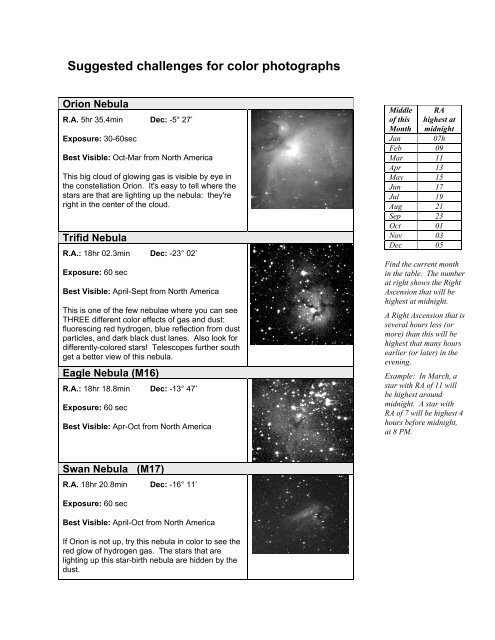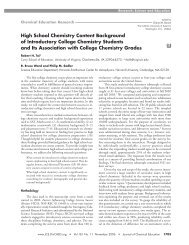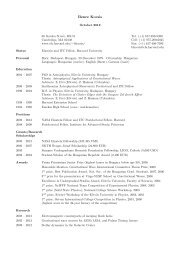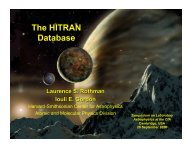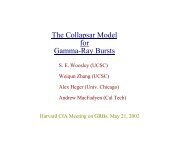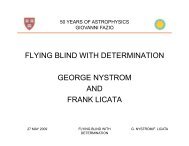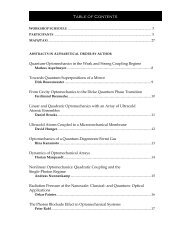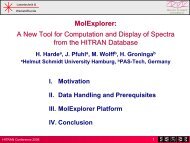What does the universe look like in color?
What does the universe look like in color?
What does the universe look like in color?
Create successful ePaper yourself
Turn your PDF publications into a flip-book with our unique Google optimized e-Paper software.
Suggested challenges for <strong>color</strong> photographs<br />
Orion Nebula<br />
R.A. 5hr 35.4m<strong>in</strong> Dec: -5° 27’<br />
Exposure: 30-60sec<br />
Best Visible: Oct-Mar from North America<br />
This big cloud of glow<strong>in</strong>g gas is visible by eye <strong>in</strong><br />
<strong>the</strong> constellation Orion. It's easy to tell where <strong>the</strong><br />
stars are that are light<strong>in</strong>g up <strong>the</strong> nebula: <strong>the</strong>y're<br />
right <strong>in</strong> <strong>the</strong> center of <strong>the</strong> cloud.<br />
Trifid Nebula<br />
R.A.: 18hr 02.3m<strong>in</strong> Dec: -23° 02’<br />
Exposure: 60 sec<br />
Best Visible: April-Sept from North America<br />
This is one of <strong>the</strong> few nebulae where you can see<br />
THREE different <strong>color</strong> effects of gas and dust:<br />
fluoresc<strong>in</strong>g red hydrogen, blue reflection from dust<br />
particles, and dark black dust lanes. Also <strong>look</strong> for<br />
differently-<strong>color</strong>ed stars! Telescopes fur<strong>the</strong>r south<br />
get a better view of this nebula.<br />
Eagle Nebula (M16)<br />
R.A.: 18hr 18.8m<strong>in</strong> Dec: -13° 47’<br />
Exposure: 60 sec<br />
Best Visible: Apr-Oct from North America<br />
Swan Nebula (M17)<br />
R.A. 18hr 20.8m<strong>in</strong> Dec: -16° 11’<br />
Exposure: 60 sec<br />
Best Visible: April-Oct from North America<br />
If Orion is not up, try this nebula <strong>in</strong> <strong>color</strong> to see <strong>the</strong><br />
red glow of hydrogen gas. The stars that are<br />
light<strong>in</strong>g up this star-birth nebula are hidden by <strong>the</strong><br />
dust.<br />
Middle<br />
of this<br />
Month<br />
RA<br />
highest at<br />
midnight<br />
Jan 07h<br />
Feb 09<br />
Mar 11<br />
Apr 13<br />
May 15<br />
Jun 17<br />
Jul 19<br />
Aug 21<br />
Sep 23<br />
Oct 01<br />
Nov 03<br />
Dec 05<br />
F<strong>in</strong>d <strong>the</strong> current month<br />
<strong>in</strong> <strong>the</strong> table. The number<br />
at right shows <strong>the</strong> Right<br />
Ascension that will be<br />
highest at midnight.<br />
A Right Ascension that is<br />
several hours less (or<br />
more) than this will be<br />
highest that many hours<br />
earlier (or later) <strong>in</strong> <strong>the</strong><br />
even<strong>in</strong>g.<br />
Example: In March, a<br />
star with RA of 11 will<br />
be highest around<br />
midnight. A star with<br />
RA of 7 will be highest 4<br />
hours before midnight,<br />
at 8 PM.


